
Express Checkout
We know your time is valuable, and now you can save more of it! As a registered member, all your information is stored for you so you can click through checkout with ease!
Promotions & Offers
You will have the option to receive information about our special offers and promotions. Our emails and catalogs will keep you updated on great deals for what's new and what's hot!
Receive 25 Free Reward Point
Receive 25 reward point™ FREE just for registering! Every purchase earns you rewards and every items is worth different amount of reward point. So, remember, the more you shop, the more you earn.
There are many circumstances that will affect the plants and flowers that you may have or are growing: sunlight, water, humidity and fertilizer. We have provided some information for you to choose from and hope you will find this to be of use.
This is just a general overview of various commonly used plants and should provide you with similar situations to look for with the plants that you may already have or be going to purchase.
African Violets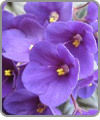 Like a moderately bright light but no exposure to direct sun. Water when the soil feels dry to the touch and provide good drainage. Cold water on the foliage may cause leaf spotting. Drain excess water from the plant saucer to prevent root rot and to protect furniture. Violets prefer a 70-72 degree daytime temperature and 65-70 degrees at night. Fertilize with Violet food following the manufacturers directions. Like a moderately bright light but no exposure to direct sun. Water when the soil feels dry to the touch and provide good drainage. Cold water on the foliage may cause leaf spotting. Drain excess water from the plant saucer to prevent root rot and to protect furniture. Violets prefer a 70-72 degree daytime temperature and 65-70 degrees at night. Fertilize with Violet food following the manufacturers directions.
|
Ferns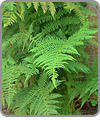 Like moist soil and bright indirect light. In Victorian times they were placed in the bath and the parlor. Ferns do not like to sit in water and require good drainage for proper growth. Temperatures in most homes are sufficient for the growth of ferns but the addition of a tray filled with pebbles and water on which the fern sits will boost the moisture around the plant and provide a better growing area. Like moist soil and bright indirect light. In Victorian times they were placed in the bath and the parlor. Ferns do not like to sit in water and require good drainage for proper growth. Temperatures in most homes are sufficient for the growth of ferns but the addition of a tray filled with pebbles and water on which the fern sits will boost the moisture around the plant and provide a better growing area.
|
|
Azaleas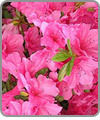 Prefer diffused light and may be planted outside under a shade tree, as direct sun will burn the foliage and provide an entrance for disease entry. Uniformly moist soil but not having water sitting in the drainage container. Azaleas prefer a cooler temperature for the best growth. Placing them in a cooler area for the night will help in keeping the blooms on the plant longer. Prefer diffused light and may be planted outside under a shade tree, as direct sun will burn the foliage and provide an entrance for disease entry. Uniformly moist soil but not having water sitting in the drainage container. Azaleas prefer a cooler temperature for the best growth. Placing them in a cooler area for the night will help in keeping the blooms on the plant longer.
|
Gloxinias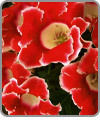 Mostly are grown for their brightly colored blooms and unique foliage. Again, they prefer a bright diffused light and moist but not wet soil. Moderate temperatures in most homes will be sufficient to the growth of gloxinias, but no temperatures below 50 degrees. Fertilize with an all purpose fertilizer following the manufacturers directions. Old blooms should be removed from the plant to help the development of new blooms. Mostly are grown for their brightly colored blooms and unique foliage. Again, they prefer a bright diffused light and moist but not wet soil. Moderate temperatures in most homes will be sufficient to the growth of gloxinias, but no temperatures below 50 degrees. Fertilize with an all purpose fertilizer following the manufacturers directions. Old blooms should be removed from the plant to help the development of new blooms.
|
|
Begonias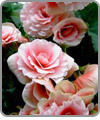 Bright diffused light near a sunny window, but not in direct sunlight. Moderately moist soil but not standing in water. Temperatures should be in the low 70 degree range in the day and in the upper 60's at night. Fertilize with an all purpose fertilizer following the manufacturers directions. Trimming of the growing ends of the plants will help to maintain a compact growth on the plants. Bright diffused light near a sunny window, but not in direct sunlight. Moderately moist soil but not standing in water. Temperatures should be in the low 70 degree range in the day and in the upper 60's at night. Fertilize with an all purpose fertilizer following the manufacturers directions. Trimming of the growing ends of the plants will help to maintain a compact growth on the plants.
|
Green Foliage Plants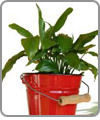 Consist of many plants that will fall into this category. Dracaena, corn plants, rubber plants, ficus, pothos, philodendron and many more will all benefit from having bright indirect light and no direct sun. A moderate amount of moisture that will require having water when the soil feels dry to the touch. Provide good drainage as the plant sitting in water will promote root rot and poor aeration. Fertilize with a green plant fertilizer following the manufacturers directions. Consist of many plants that will fall into this category. Dracaena, corn plants, rubber plants, ficus, pothos, philodendron and many more will all benefit from having bright indirect light and no direct sun. A moderate amount of moisture that will require having water when the soil feels dry to the touch. Provide good drainage as the plant sitting in water will promote root rot and poor aeration. Fertilize with a green plant fertilizer following the manufacturers directions.
|
|
Blooming Plants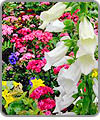 These would include mum plants, kalanchoe, cyclamen, begonia, violets and others that generate a bloom for the use of the color at certain times of the year. These plants should be kept moist but not sitting in a container of water. Standing water would prevent the soil from allowing air transfer to occur between the roots and the air. Most of these plants like a bright light and no direct sun which may cause sunburn of the leaves. These would include mum plants, kalanchoe, cyclamen, begonia, violets and others that generate a bloom for the use of the color at certain times of the year. These plants should be kept moist but not sitting in a container of water. Standing water would prevent the soil from allowing air transfer to occur between the roots and the air. Most of these plants like a bright light and no direct sun which may cause sunburn of the leaves.
|
Orchids Have a unique growing requirement all their own. The plants are grown in a soil-less medium that doesn't hold water. Plants are originally growing in trees and need to get their moisture from rain or from having fog or other moisture in the air. These plants need to have a good watering twice a week. They also benefit from having the foliage misted. Moderate temperatures for orchids and fertilizing with an orchid specific fertilizer following the manufacturers directions. Have a unique growing requirement all their own. The plants are grown in a soil-less medium that doesn't hold water. Plants are originally growing in trees and need to get their moisture from rain or from having fog or other moisture in the air. These plants need to have a good watering twice a week. They also benefit from having the foliage misted. Moderate temperatures for orchids and fertilizing with an orchid specific fertilizer following the manufacturers directions.
|
|
Dish Gardens (Planters)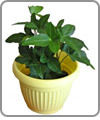 Usually consist of a combination of low light level plants that have similar growing conditions. This may vary depending on the varieties of plants used but most will be able to tolerate low light levels and like to be moist but not standing in water. Watering may prove to be a bit tricky since most planters are not equipped with a drainage hole in the bottom of the container. This will require you to be more watchful on the water and how the soil is drying out to the touch. A lot of planters are sent with fresh flowers in water tubes that will require filling and after the blooms have faded need to be removed from the container. Usually consist of a combination of low light level plants that have similar growing conditions. This may vary depending on the varieties of plants used but most will be able to tolerate low light levels and like to be moist but not standing in water. Watering may prove to be a bit tricky since most planters are not equipped with a drainage hole in the bottom of the container. This will require you to be more watchful on the water and how the soil is drying out to the touch. A lot of planters are sent with fresh flowers in water tubes that will require filling and after the blooms have faded need to be removed from the container.
|
Peace Lilies (Spathiphyllum)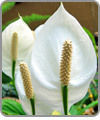 Is a good plant for a low light area and will still provide you with blooms on a regular basis. Soil should be moist but not soggy since this would promote root rot and poor aeration. Moderate household temperatures and a fertilizing schedule following manufacturers directions from general green plant fertilizer. Peace Lily will also benefit from the addition of organic matter to their soil. Is a good plant for a low light area and will still provide you with blooms on a regular basis. Soil should be moist but not soggy since this would promote root rot and poor aeration. Moderate household temperatures and a fertilizing schedule following manufacturers directions from general green plant fertilizer. Peace Lily will also benefit from the addition of organic matter to their soil.
|